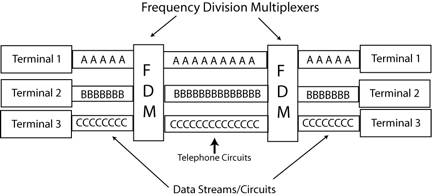Chapter 3 - Data Communications: Emergence 1956-1968
3.6 Multiplexer Innovation: American Data Systems 1966-1968
The same dynamics that were driving the potential buying demand for modems were having a more immediate impact on multiplexers, the second great product of data communications. Multiplexers make it possible for many users to share the same communication channel at the same time.
Multiplexers date to the days of the telegraph, and, although incrementally innovated over time, performed the same task as when first created: subdividing a communication channel into a larger number of channels. State-of-the-art in the early 1960’s were frequency division multiplexers (FDMs). Developed by the telephone and telegraph companies in the 1930’s and 1940’s, FDMs partitioned the frequency of an analog voice channel into multiple lower speed subchannels with each subchannel occupying a defined range of frequencies separated by frequency guard bands or safety zones.68 (See Exhibit 3.6.1 Frequency Division Multiplexer.)
Exhibit 3.6.1 Frequency Division Multiplexer

The need for guard bands imposed a practical limit on the bandwidth of a FDM to 1800 bps to 2000 bps.69 However, as computer terminals were particularly slow (75-150 bps), a large number of terminals could be supported by FDMs. FDMs did not require modems - another advantage. Even so, as the number of terminals that needed to be connected to computers increased, a new solution was needed - one to be innovated by a new start-up.
In 1966, Art Wilkes received an offer too good to pass up, and resigned from AT&T to work for his best customer, Scantlin Electronics (SE).70 His job was to sell their newest FDM capable of connecting 150 terminals to one 2400 bps circuit.71 SE’s business of leasing on-line stock-quote terminals to brokerage firms and other financial organizations was booming and Wilkes had no problem getting them interested in the new FDM. Concurrently, Wilkes’ boss, Bob Schaaf, was writing a business plan to launch SE into the product business, presumably to sell their FDMs. Schaaf, however, surprisingly recommended selling a yet to be developed line of time division multiplexers (TDMs), a recommendation that was summarily rejected. Around this same time, late 1967, Wilkes was let go for not meeting sales quotas, despite the fact that the FDM did not work. Wilkes and Schaaf would strike deals leaving them free to pursue any ideas developed at SE in return for foregoing any owed compensation and stock options from the company. Immediately they began planning to start of a company selling the TDMs they would develop. In January 1967 they incorporated their new company: American Data Systems (ADS).
Time division multiplexers did away with the notion of frequency sub-channels inherent to FDMs and instead gave every connecting terminal, or device, a fixed time slot on a rotating basis. (See Exhibit 3.6.2 Time Division Multiplexer) The effect was to dramatically increase the number of terminals or devices that could be serviced by a factor of four, and with incremental innovation over time, by a factor of ten. TDMs, unlike FDMs, required modems for they needed a digital circuit made possible by modems.
Exhibit 3.6.2 Time Division Multiplexer

In need of someone to engineer and build some prototypes, Wilkes called his college roommate, William Norred, a site engineer with a technical support company for the Apollo moon program. Norred remembers:
I was responsible for everything from sweeping the floors up through the storage of rocket propellants. Art called me one day and said: “I’m thinking about starting a company. Would you like to participate in it?” I said: ‘Yes. What are you going to do?’ He said: ‘We’re going to make modems and multiplexers,’ and I said: ‘What’s a modem? And what’s a multiplexer?’
Ignorance did not deter Norred who readily said “Yes.” He and his wife gathered their few belongings, packed them into their car and, in February 1968, drove from Texas to California:
When I arrived, Art told me that the money had fallen through. I said: ‘That’s fine. I’m moving in with you,’ and I actually lived in his den for a number of months. In fact, the first multiplexer was built in his garage.
Norred began building the TDM, while Wilkes and Schaaf searched for funding.
- [68]:
Datapro, September 1983, Multiplexers C35-010-103
- [69]:
Dixon R. Doll, Data Communications, John Wiley & Sons, 1978, pps. 308-309
- [70]:
Scantlin Electronics was one of the most technologically advanced companies of its day. It would become Quotron Corporation and then be bought by Citicorp.
- [71]:
Built with RTL logic, the unit ran so hot it had to be installed on rooftops for cooling. It was said you could cook eggs on it.